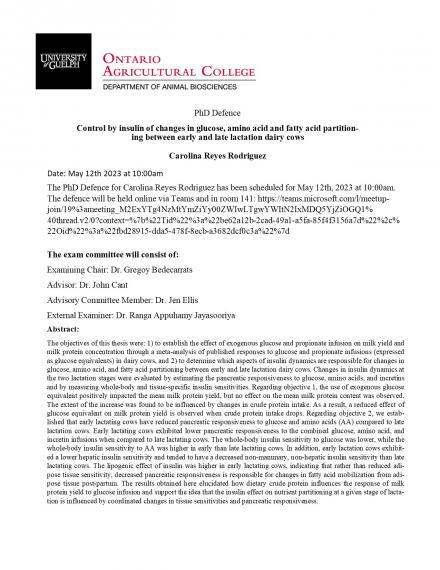Carolina Reyes Rodriguez's PhD Defence
Date and Time
Location
Room 141 and Teams: https://teams.microsoft.com/l/meetup-join/19%3ameeting_M2ExYTg4NzMtYmZiYy00ZWIwLTgwYWItN2IxMDQ5YjZiOGQ1%40thread.v2/0?context=%7b%22Tid%22%3a%22be62a12b-2cad-49a1-a5fa-85f4f3156a7d%22%2c%22Oid%22%3a%22fbd28915-dda5-478f-8ecb-a3682dcf0c3a%22%7d

Details
Control by insulin of changes in glucose, amino acid and fatty acid partition-ing between early and late lactation dairy cows
The objectives of this thesis were: 1) to establish the effect of exogenous glucose and propionate infusion on milk yield and milk protein concentration through a meta-analysis of published responses to glucose and propionate infusions (expressed as glucose equivalents) in dairy cows, and 2) to determine which aspects of insulin dynamics are responsible for changes in glucose, amino acid, and fatty acid partitioning between early and late lactation dairy cows. Changes in insulin dynamics at the two lactation stages were evaluated by estimating the pancreatic responsiveness to glucose, amino acids, and incretins and by measuring whole-body and tissue-specific insulin sensitivities. Regarding objective 1, the use of exogenous glucose equivalent positively impacted the mean milk protein yield, but no effect on the mean milk protein content was observed. The extent of the increase was found to be influenced by changes in crude protein intake. As a result, a reduced effect of glucose equivalent on milk protein yield is observed when crude protein intake drops. Regarding objective 2, we estab-lished that early lactating cows have reduced pancreatic responsiveness to glucose and amino acids (AA) compared to late lactation cows. Early lactating cows exhibited lower pancreatic responsiveness to the combined glucose, amino acid, and incretin infusions when compared to late lactating cows. The whole-body insulin sensitivity to glucose was lower, while the whole-body insulin sensitivity to AA was higher in early than late lactating cows. In addition, early lactation cows exhibit-ed a lower hepatic insulin sensitivity and tended to have a decreased non-mammary, non-hepatic insulin sensitivity than late lactating cows. The lipogenic effect of insulin was higher in early lactating cows, indicating that rather than reduced adi-pose tissue sensitivity, decreased pancreatic responsiveness is responsible for changes in fatty acid mobilization from adi-pose tissue post-partum. The results obtained here elucidated how dietary crude protein influences the response of milk protein yield to glucose infusion and support the idea that the insulin effect on nutrient partitioning at a given stage of lacta-tion is influenced by coordinated changes in tissue sensitivities and pancreatic responsiveness.